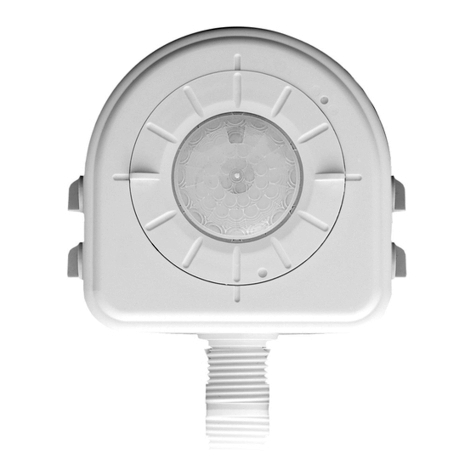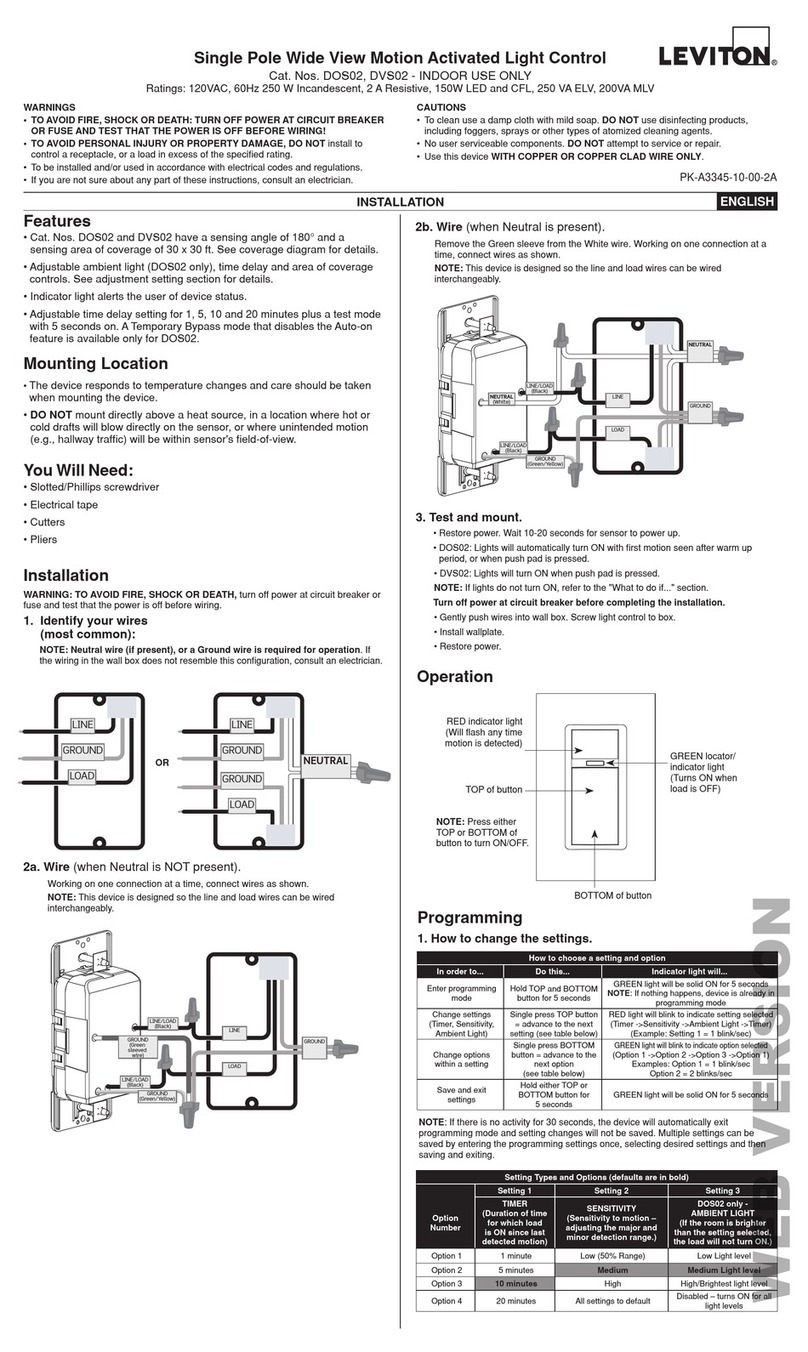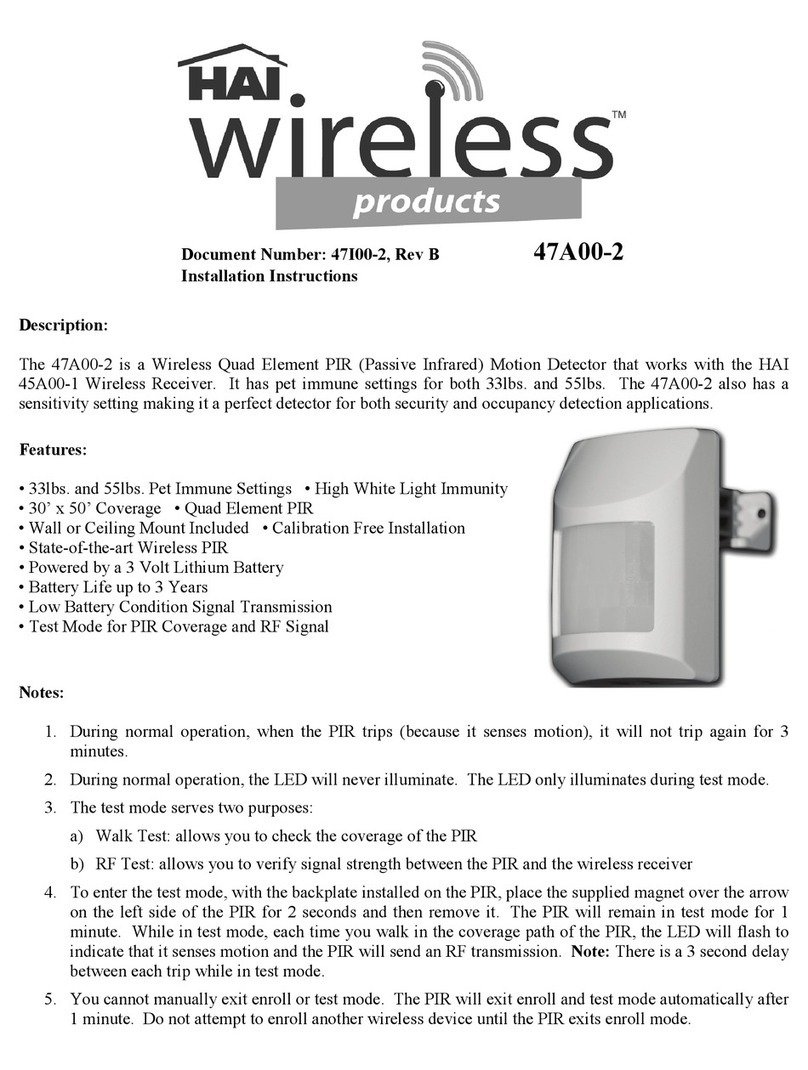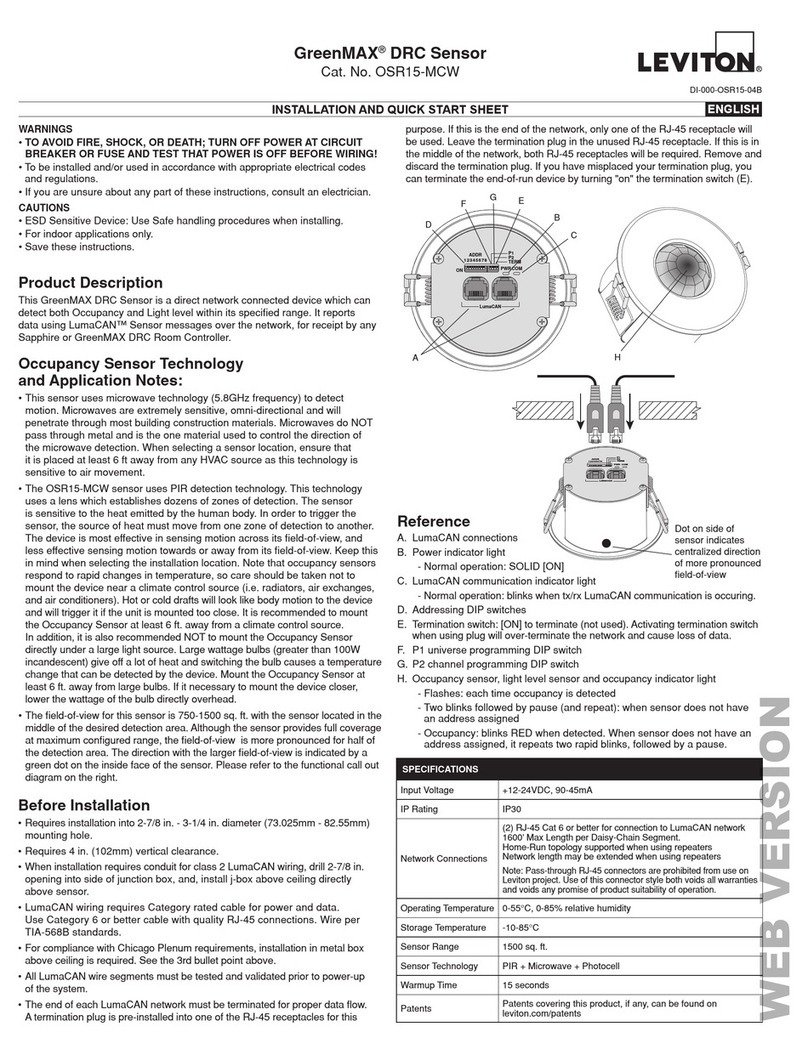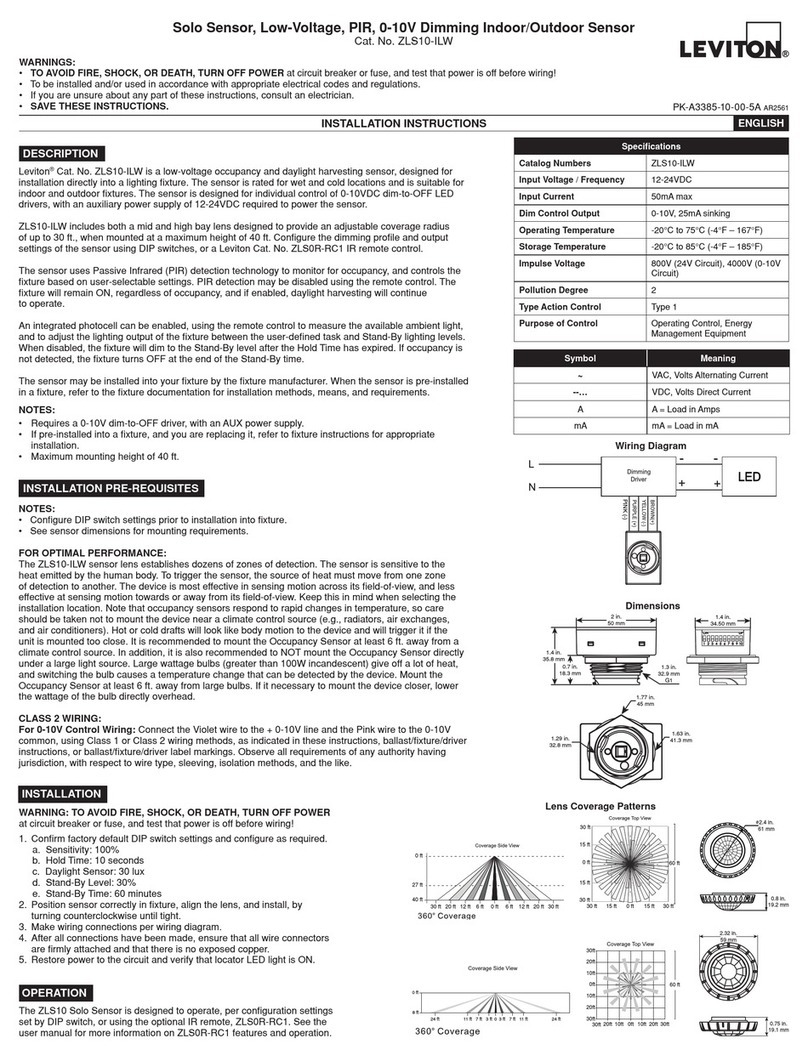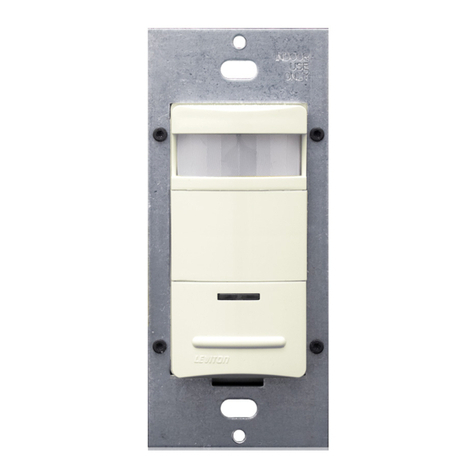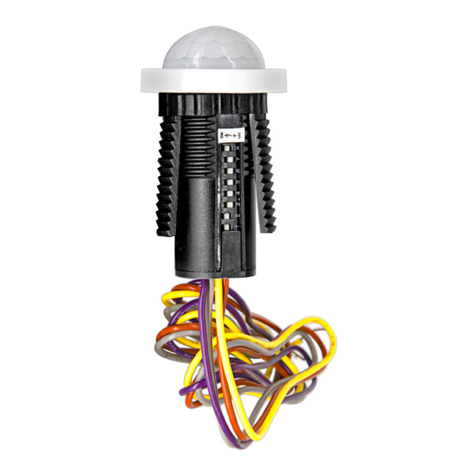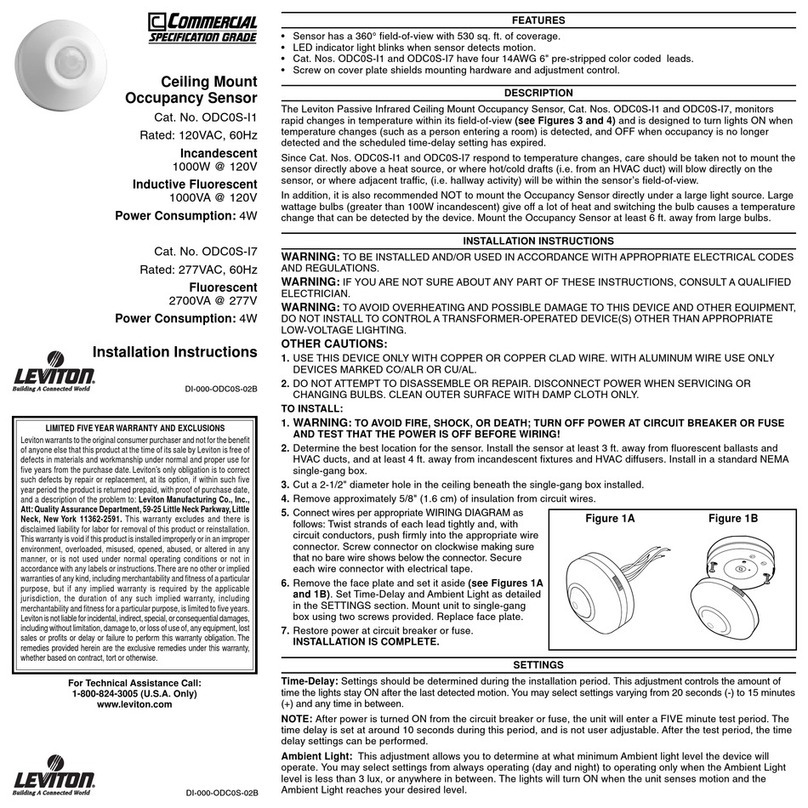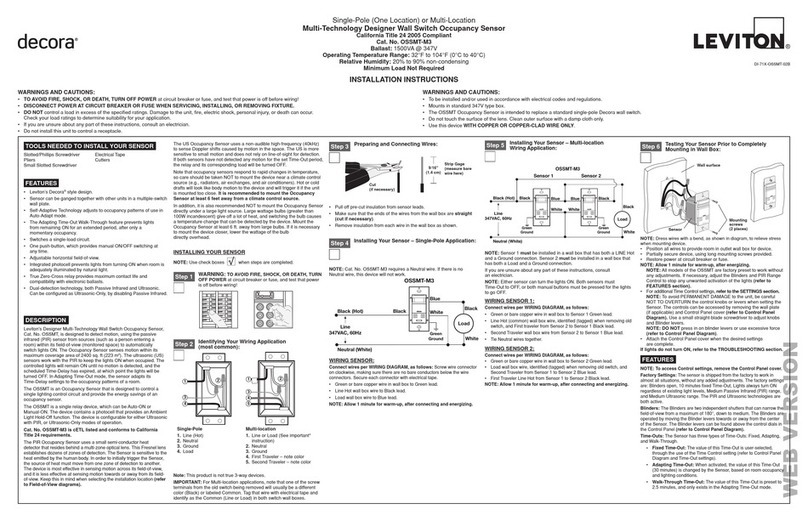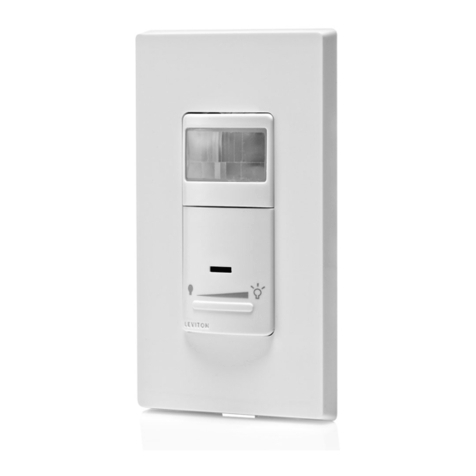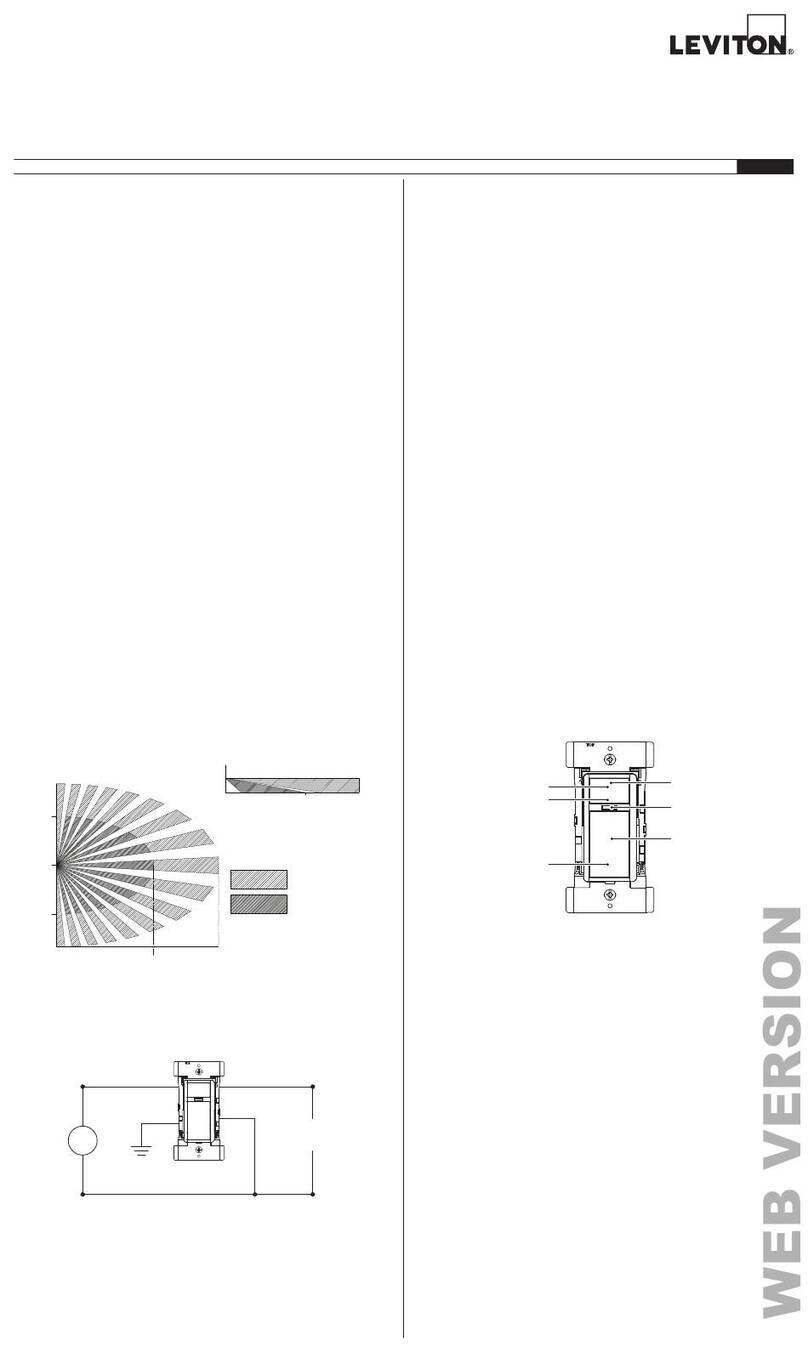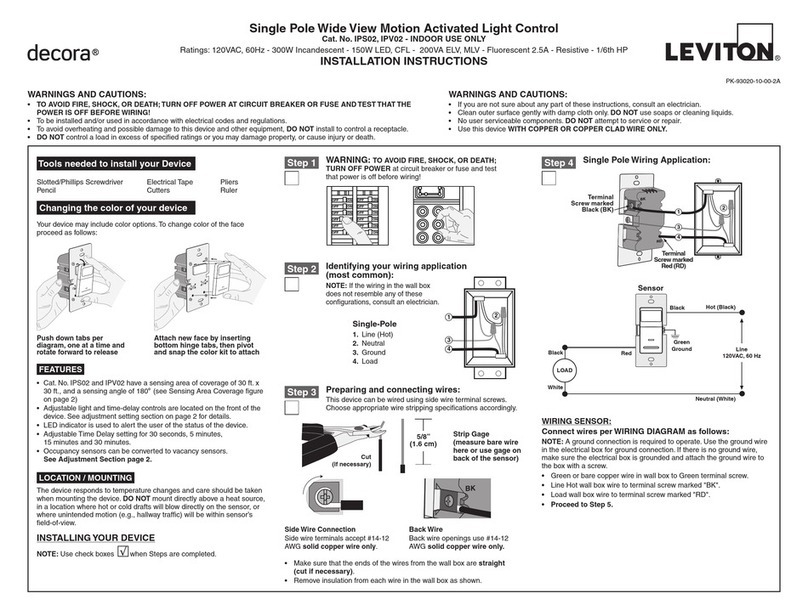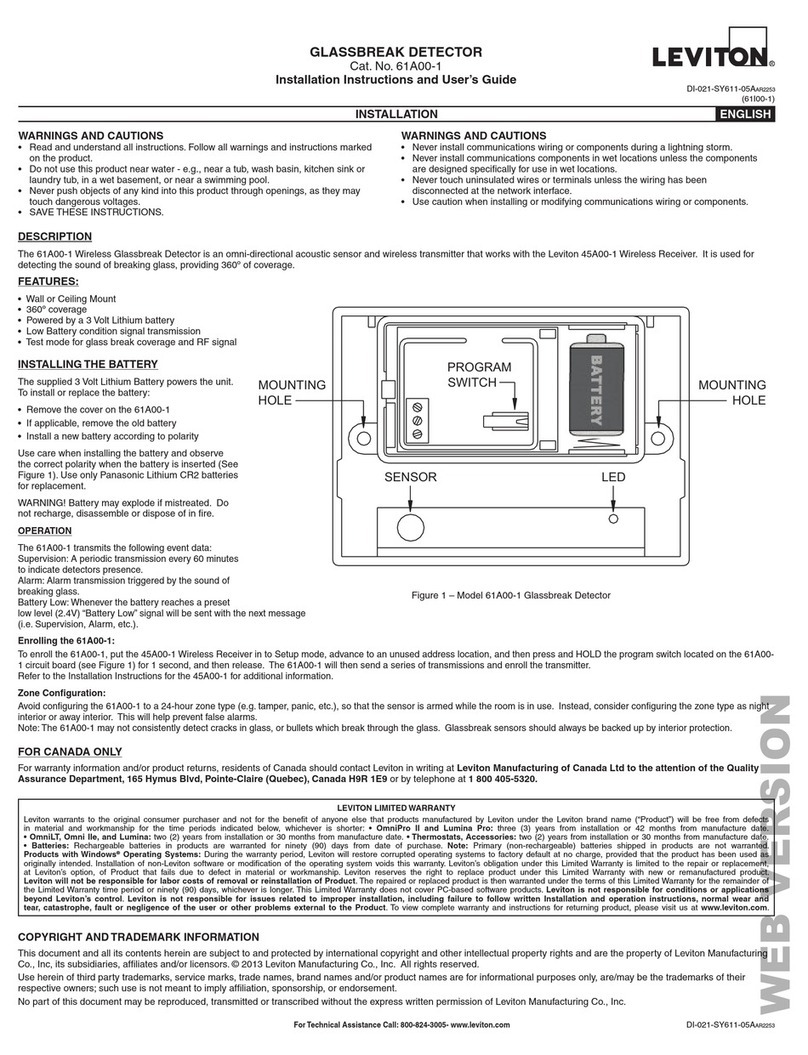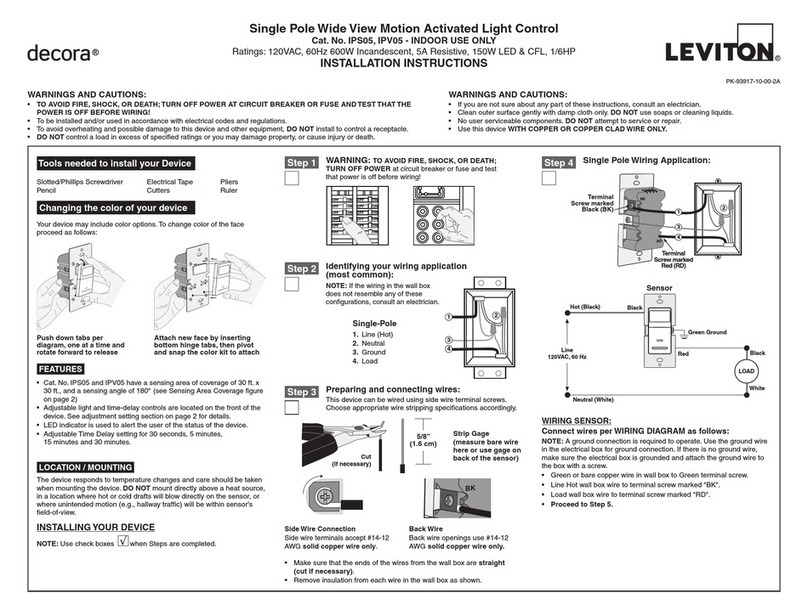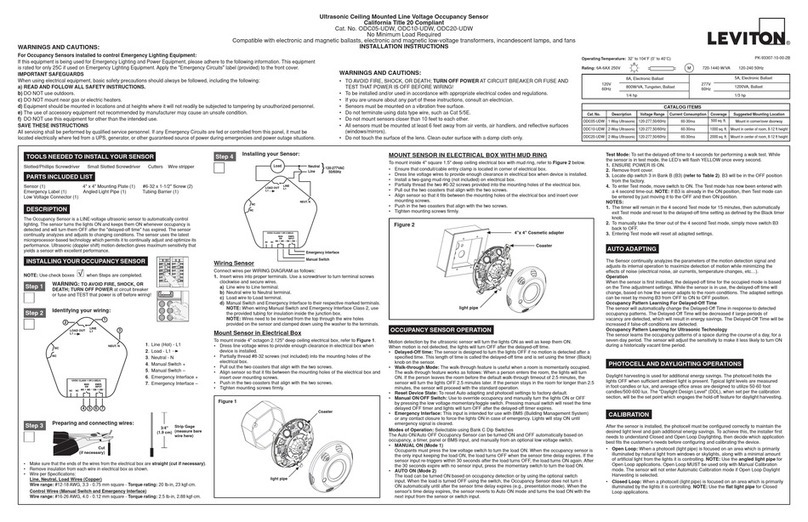
NOTE: Use check boxes when Steps are completed.
Infrared Ceiling Mounted Occupancy Sensor
California Title 20 Compliant
Cat. Nos. ODC
Ø
4-IDW, ODC15-IDW
No Minimum Load Required
Compatible with electronic and magnetic ballasts, electronic and magnetic low-voltage transformers, incandescent lamps, and fans
INSTALLATION INSTRUCTIONS
TOOLS NEEDED TO INSTALL YOUR SENSOR
DESCRIPTION
Slotted/Phillips Screwdriver Small Slotted Screwdriver Cutters Wire stripper
PARTS INCLUDED LIST
INSTALLING YOUR OCCUPANCY SENSOR
Sensor (1) 4" x 4" Mounting Plate (1) #6-32 x 1-1/2" Screw (2)
Mid-Range Lens (1) Emergency Label (1) Angled Light Pipe (1)
360˚ Perforated Mask (1) Low Voltage Connector (1) Half Mask (1)
Tubing Barrier (1)
The Occupancy Sensor is a LINE-voltage infrared sensor to automatically control lighting.
The sensor turns the lights ON and keeps them ON whenever occupancy is detected
and will turn them OFF after the "delayed-off time" has expired. The sensor continually
analyzes and adjusts to changing conditions. The sensor uses the latest microprocessor-
based technology which permits it to continually adjust and optimize its performance.
Infrared motion detection gives higher false triggering immunity that yields a sensor with
excellent performance.
Wiring Sensor
Connect wires per WIRING DIAGRAM as follows:
1. Insert wires into proper terminals. Use a screwdriver to turn terminal screws
clockwise and secure wires.
a) Line wire to Line terminal.
b) Neutral wire to Neutral terminal.
c) Load wire to Load terminal.
d)
Manual Switch and Emergency Interface to their respective marked terminals.
NOTE: When wiring Manual Switch and Emergency Interface Class 2, use
the provided tubing for insulation inside the junction box.
Mount Sensor in Electrical Box
To mount inside 4" octagon 2.125" deep ceiling electrical box, refer to Figure 1.
•Dress line voltage wires to provide enough clearance in electrical box when
device is installed.
• Partiallythreadtwo#8-32screws(notincluded)intothemountingholesofthe
electrical box.
• Pulloutthetwocoastersthatalignwiththetwoscrews.
• Alignsensorsothatittsbetweenthemountingholesoftheelectricalboxand
insert over mounting screws.
• Pushinthetwocoastersthatalignwiththetwoscrews.
• Tightenmountingscrewsrmly.
MOUNT SENSOR IN ELECTRICAL BOX WITH MUD RING
To mount inside 4" square 1.5" deep ceiling electrical box with mud ring, refer to Figure 2 below.
• Ensure that conduit/cable entry clamp is located in corner of electrical box.
•Dress line voltage wires to provide enough clearance in electrical box when device is installed.
• Installatwo-gangmudring(notincluded)onelectricalbox.
• Partiallythreadthetwo#6-32screwsprovidedintothemountingholesoftheelectricalbox.
• Pulloutthetwocoastersthatalignwiththetwoscrews.
• Alignsensorsothatittsbetweenthemountingholesoftheelectricalboxandinsertover
mounting screws.
• Pushinthetwocoastersthatalignwiththetwoscrews.
• Tightenmountingscrewsrmly.
PK-93306-10-00-2A-X2
Figure 1
•
Make sure that the ends of the wires from the electrical box are straight (cut if necessary).
• Removeinsulationfromeachwireinelectricalboxasshown.
• WireperSpecications:
Line, Neutral, Load Wires (Copper)
Wire range:#12-18AWG,3.3-0.75mmsquare-Torque rating: 20 lb-in, 23 kgf-cm.
Control Wires (Manual Switch and Emergency Interface)
Wire range: #16-26 AWG, 4.0 - 0.12 mm square - Torque rating:2.5lb-in,2.88kgf-cm.
Preparing and connecting wires:
Cut
(if necessary)
3/4"
(1.9 cm)
Strip Gage
(measure bare
wire here)
Step 3
ONOFF
ONOFF
ONOFF
ONOFF
ONOFF
ONOFF
ONOFFONOFF
ONOFF
ONOFF
ONOFF
ONOFF
Step 1 WARNING: TO AVOID FIRE, SHOCK, OR
DEATH; TURN OFF POWER at circuit breaker
or fuse and TEST that power is off before wiring!
WARNINGS AND CAUTIONS:
• TO AVOID FIRE, SHOCK, OR DEATH; TURN OFF POWER AT CIRCUIT BREAKER OR FUSE AND
TEST THAT POWER IS OFF BEFORE WIRING!
• Tobeinstalledand/orusedinaccordancewithappropriateelectricalcodesandregulations.
• Ifyouareunsureaboutanypartoftheseinstructions,consultanelectrician.
• Sensorsmustbemountedonavibrationfreesurface.
• Donotterminateusingdatatypewire,suchasCat5/5E.
• Donotmountsensorscloserthan10feettoeachother.
• Allsensorsmustbemountedatleast6feetawayfromairvents,airhandlers,andreectivesurfaces
(windows/mirrors).
• Donottouchthesurfaceofthelens.Cleanoutersurfacewithadampclothonly.
WARNINGS AND CAUTIONS:
For Occupancy Sensors installed to control Emergency Lighting Equipment:
If this equipment is being used for Emergency Lighting and Power Equipment, please adhere to the following information. This equipment
is rated for only 25C if used on Emergency Lighting Equipment. Apply the "Emergency Circuits" label (provided) to the front cover.
IMPORTANT SAFEGUARDS
When using electrical equipment, basic safety precautions should always be followed, including the following:
a) READ AND FOLLOW ALL SAFETY INSTRUCTIONS.
b) DO NOT use outdoors.
c) DO NOT mount near gas or electric heaters.
d) Equipment should be mounted in locations and at heights where it will not readily be subjected to tampering by unauthorized personnel.
e) The use of accessory equipment not recommended by manufacturer may cause an unsafe condition.
f) DO NOT use this equipment for other than the intended use.
SAVE THESE INSTRUCTIONS
Allservicingshallbeperformedbyqualiedservicepersonnel.IfanyEmergencyCircuitsarefedorcontrolledfromthispanel,itmustbe
located electrically where fed from a UPS, generator, or other guaranteed source of power during emergencies and power outage situations.
Mount in center of
room/area,8-12ftheight
Mount in center of
room/area,8-12ftheight
Suggested Mounting Location
450 sq. ft.
1500 sq. ft.
Coverage
ODC04-IDW
ODC15-IDW
Cat. No.
High
Density
Extended
Range
Description
120-277,50/60Hz
120-277,50/60Hz
Voltage Range
60-30ma
60-30ma
Current Consumption
CATALOG ITEMS
Identifying your wiring:
Step 2
4 5 6 7
3
1
2
LOAD OUT
L1
LINE
L1
NEUT. N
NC
NC
12VDC CLASS 1 OR 2 (SELV)
MAN
SW
NC NC MS +–+–
MS EM EM
EMER.
INPUT
Installing your Sensor:
Step 4
12VDC CLASS 1 OR 2 (SELV)
MAN
SW
NC NC MS +–+–
MS EM EM
EMER.
INPUT
Emergency Interface
Neutral 120-277VAC
50/60Hz
}
Line
Manual Switch
Load
LOAD OUT
L1
LINE
L1
NEUT. N
NC
NC
PHOTOCELL AND DAYLIGHTING OPERATIONS
Daylight harvesting is used for additional energy savings. The photocell holds the
lightsOFFwhensufcientambientlightispresent.Typicallightlevelsaremeasured
infoot-candlesorlux,andaverageofceareasaredesignedtoutilize50-60foot
candles/500-600 lux. The "Daylight Design Level" (DDL), when set per the calibration
section, will be the set point which engages the hold-off feature for daylight harvesting.
120V
60Hz
277V
60Hz
800W/VA,Tungsten,Ballast
8A,ElectronicBallast
1/4 hp
1200VA, Ballast
5A, Electronic Ballast
1/3 hp
Rating: 6A-6AX 250V
Operating Temperature: 32˚ to 104˚F (0˚ to 40˚C)
720-1440W/VA 120-240 50HzM
CALIBRATION
Afterthesensorisinstalled,thephotocellmustbeconguredcorrectlytomaintainthe
desiredlightlevelandgainadditionalenergysavings.Toachievethis,theinstallerrst
needs to understand Closed and Open Loop Daylighting, then decide which application
besttsthecustomer'sneedsbeforeconguringandcalibratingthedevice.
• Open Loop: When a photocell (light pipe) is focused on an area which is primarily
illuminated by natural light from windows or skylights, along with a minimal amount
ofarticiallightfromthelightsitiscontrolling.NOTE: Use the angled light pipe for
Open Loop applications. Open Loop MUST be used only with Manual Calibration
mode. The sensor will not enter Automatic Calibration mode if Open Loop Daylight
Harvesting is selected.
• Closed Loop: When a photocell (light pipe) is focused on an area which is primarily
illuminated by the lights it is controlling. NOTE: Use the flat light pipe for Closed
Loop applications.
Figure 2
1. Line (Hot) - L1
2. Load - L1
3. Neutral - N
4. Manual Switch +
5. Manual Switch –
6. Emergency Interface +
7. Emergency Interface –
OCCUPANCY SENSOR OPERATION
Motion detection by the infrared sensor will turn the lights ON as well as keep them ON.
When motion is not detected, the lights will turn OFF after the delayed-off time.
• Delayed-Off time: The sensor is designed to turn the lights OFF if no motion is detected after a
speciedtime.Thislengthoftimeiscalledthedelayed-offtimeandissetusingthetimer(Black)
knob on the sensor.
• Walk-through Mode: The walk-through feature is useful when a room is momentarily occupied.
The walk-through feature works as follows: When a person enters the room, the lights will turn
ON. If the person leaves the room before the default walk-through timeout of 2.5 minutes, the
sensor will turn the lights OFF 2.5 minutes later. If the person stays in the room for longer than 2.5
minutes, the sensor will proceed with the standard operation.
• Reset Device State: To reset Auto adapting and photocell settings to factory default.
• Manual ON/OFF Switch: Use to override occupancy and manually turn the lights ON or OFF
by pressing the low voltage momentary/toggle switch. Pressing manual switch will reset the time
delayed OFF timer and lights will turn OFF after the delayed-off timer expires.
• Emergency Interface: This input is intended for use with BMS (Building Management System)
or any contact closure to force the lights ON in case of emergency. Lights will stay ON until
emergency signal is cleared.
Modes of Operation: Selectable using Bank C Dip Switches
The Auto ON/Auto OFF Occupancy Sensor can be turned ON and OFF automatically based on
occupancy, a timer, panel or BMS input, and manually from an optional low voltage switch.
• MANUAL ON (Mode 1)
Occupants must press the low voltage switch to turn the load ON. When the occupancy sensor is
the only input keeping the load ON, the load turns OFF when the sensor time delay expires. If the
sensor input re-triggers within 30 seconds after the load turns OFF, the load turns ON again. After
the 30 seconds expire with no sensor input, press the momentary switch to turn the load ON.
• AUTO ON (Mode 2)
The load can be turned ON based on occupancy detection or by using the optional switch
input. When the load is turned OFF using the switch, the Occupancy Sensor does not turn it
ON automatically until after the sensor time delay expires (e.g., presentation mode). When the
sensor'stimedelayexpires,thesensorrevertstoAutoONmodeandturnstheloadONwiththe
next input from the sensor or switch input.
AUTO ADAPTING
The Sensor continually analyzes the parameters of the motion detection signal and
adjusts its internal operation to maximize detection of motion while minimizing the
effects of noise (electrical noise, air currents, temperature changes, etc…).
Operation
Whenthesensorisrstinstalled,thedelayed-offtimefortheoccupiedmodeisbased
on the Time adjustment settings. While the sensor is in use, the delayed-off time will
change, based on how the sensor adapts to the room conditions. The adapted settings
can be reset by moving B3 from OFF to ON to OFF position.
Occupancy Pattern Learning For Delayed-Off Time
The sensor will automatically change the Delayed-Off Time in response to detected
occupancy patterns. The Delayed-Off Time will be decreased if large periods of
vacancy are detected, which will result in energy savings. The Delayed-Off Time will be
increased if false-off conditions are detected.
Occupancy Pattern Learning for Infrared Technology
The sensor learns the occupancy patterns of a space during the course of a day, for a
seven day period. The sensor will adjust the sensitivity to make it less likely to turn ON
during a historically vacant time period.
Test Mode: To set the delayed-off time to 4 seconds for performing a walk test. While
thesensorisintestmode,theLEDwillashYELLOWonceeverysecond.
1. ENSURE POWER IS ON.
2. Remove front cover.
3. Locate dip switch 3 in Bank B (B3) (refer to Table 2). B3 will be in the OFF position
from the factory.
4. To enter Test mode, move switch to ON. The Test mode has now been entered with
a 4 second time-out. NOTE: If B3 is already in the ON position, then Test mode can
be entered by just moving it to the OFF and then ON position.
NOTES:
1. The timer will remain in the 4 second Test mode for 15 minutes, then automatically
exitTestmodeandresettothedelayed-offtimesettingasdenedbytheBlacktimer
knob.
2. To manually take the timer out of the 4 second Test mode, simply move switch B3
back to OFF.
3. Entering Test mode will reset all adapted settings.
Flat light pipe
Coaster
Angled light pipe
4"x 4" Cosmetic adapter
Coaster

